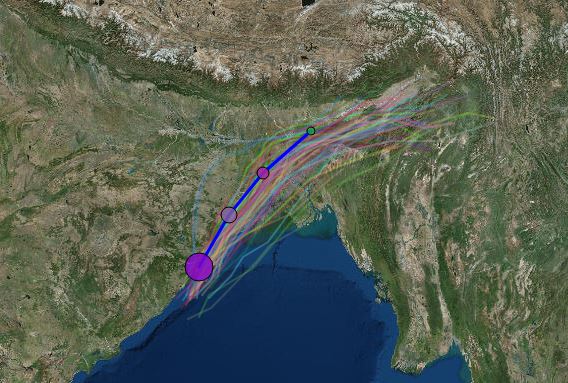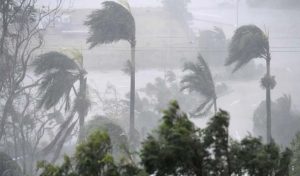PURI, India, May 3, 2019 – Cyclone Fani, one of the biggest storms to come off the Indian Ocean in recent years, slammed into India on Friday, tearing down trees, blowing away food stands and cutting off power and water, BSS/AFP reported.
Xinhua reported, three people died in India’s eastern state of Odisha as the extremely severe cyclone Fani hit the state on Friday morning and continued till beyond noon.
AFP reports, the monster weather system, which threatened to bring a dangerous storm surge that could flood low-lying areas, was packing winds of up to 180 kilometres (110 miles) an hour as it ripped into the country’s east coast.
Forecasters say the areas could see gusts of up to 200 kilometres per hour, equivalent in strength to a Category 3 to 4 hurricane.
In recent days authorities in Odisha, where 10,000 people died in a 1999 cyclone, have evacuated more than a million people as they fret about a possible 1.5-metre (five-foot) storm surge.
Hundreds of thousands more people in West Bengal state have also been given orders to flee. Special teams were moving through holiday villages urging tourists to get to safety.
India’s National Disaster Response Force shared images of several uprooted trees along the coast in Andhra Pradesh state to the south.
The NDRF teams were trying to remove the fallen trees and branches to ensure they don’t become projectiles if the winds intensify.
Fani was expected to barrel northeastwards into West Bengal state and towards Bangladesh, on a trajectory that will take it over the homes of 100 million people.
Meteorologists have warned of the “total destruction” of thatched houses, the uprooting of power and communication poles, the “flooding of escape routes” and damage to crops in some areas.
Another report said, The Odisha government has evacuated over 1 million people from the coastal areas to camps on higher grounds. The Indian army, navy, air force, coast guard and disaster management agencies are on standby.
Prime Minister Narendra Modi said over 1,000 crore Indian Rupees (around 143 million U.S. dollars) had been released in advance for the states affected by the cyclone.
Some 3,000 shelters in schools and government buildings have been set up to accommodate more than a million people in Odisha. More than 100,000 dry food packets are ready to be dropped if needed, reports said.
More than 200 trains have been cancelled along coastal routes, according to Indian Railways. Three special trains were running however from Puri to evacuate pilgrims
Flights have been
Ports have been closed but the Indian Navy has sent six warships to
Measures were also being taken
attracts millions of visitors every year.
AFP correspondents in the resort said it was a near ghost town
Electricity and water supplies were already cut for much of the city of 200,000 people.
Only a few police vehicles and tractors trying to pull trees or push aside collapsed walls could be seen.
Media reports said hundreds of trees were uprooted at the nearby Chilika Lake just south of Puri in the first violent winds.
Metal shutters covered
But a few thousand are known to have defied the evacuation orders in Puri. Some took shelter in local schools and hotels.
Krishna Chandra Sahu, 43, took seven members of his family to a city hotel to ride out the storm.
“We didn’t feel our home was safe so we came here,” he told AFP.
“We will just stay for the day until the cyclone has passed. We are not scared but we feel safer here.”
In Bangladesh, disaster management chief Mohammad Hashim said that
The country’s weather bureau has told deep-sea fishing vessels to
India’s east coast is vulnerable to destructive storms.
In 2017 Cyclone Ockhi left nearly 250 people dead and more than 600 missing in Tamil Nadu and Kerala.
The 1999 storm wreaked $4.5 billion worth of damage, as well as taking 10,000 lives.



